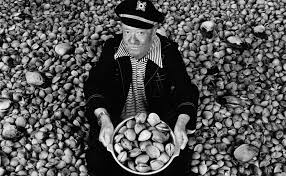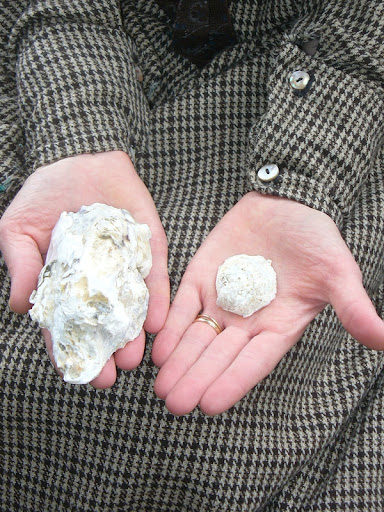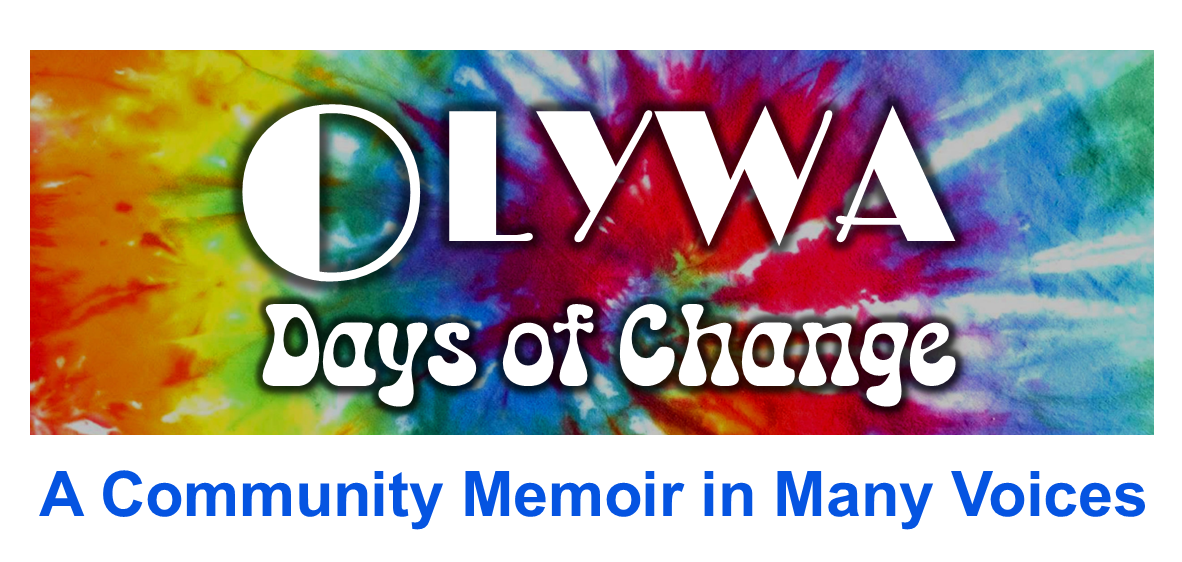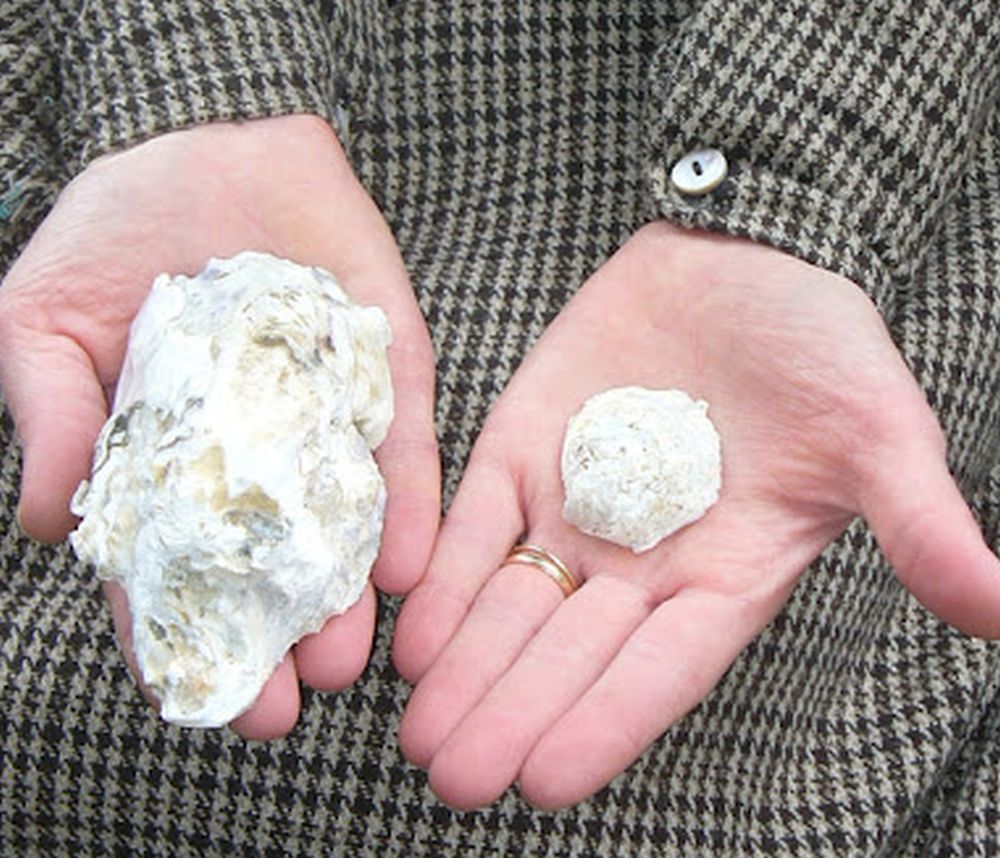ARRIVALS
Acres of Clams
By Joe Tougas
No longer a slave of ambition,
I laugh at the world and its shams.
And think of my happy condition
Surrounded by acres of clams.

For people who grew up in the ’60s “in the country they call Puget Sound,” there was a folk song that captured one of the deep-seated background assumptions in this part of the world: a sense of the abundance of the natural environment. That song, called The Old Settler, was well known from a children’s TV show popularized by a restaurateur and self-proclaimed celebrity Ivar Haglund. He owned a Seattle restaurant cleverly called Ivar’s Acres of Clams. The message of the song resonated with a sense of abundance and generosity that made an impression on young people–even on those who had no practical understanding of what was involved in harvesting that shellfish bounty.
That sense of abundance was also captured by another phrase from Indigenous culture, popular with tour guides and waterfront developers: “When the tide goes out, the table is set.” You can imagine how that sentiment would be received by young people from back east or California ending up in Olympia and hearing stories of going down to the beach and coming back with a gunny sack full of free seafood delicacies.
The folks at Cold Comfort Farm were a nice mix of native Washingtonians and immigrants from other states, and thus carried with them a mix of experiences and attitudes toward shellfish. Ernestine, for example, had grown up in Idaho Falls, a place where oysters and clams were generally looked upon with suspicion—especially oysters and clams that had, just hours before, been covered in fragrant mud of unknown composition. But Ernestine had come from a family of adventurous eaters. Her parents had convinced their children that the best part of the fried chicken was the back, and especially the pope’s nose. She also knew that free food, to be had for the taking, and from places where hardly anyone ever came around, was not to be sneezed at. And she also knew that the Joy of Cooking had easy-to-follow recipes for things like oysters Rockefeller and clam chowder (both Boston and Manhattan). So the hungry hippies of Cold Comfort soon came to appreciate a rich addition to the weekly menu.
One problem with this sweet deal from the natural world was, however, that the “table” that was set by the receding tide was generally owned by somebody—somebody who didn’t spend much time at the oyster beds, but who might show up at any time. Obviously, those property owners would know the value of their product, and know that those precious little gems were there for the taking. Ernestine’s response to the thorny issue about whether it was okay for us to “make use of abandoned property” was that it gave a whole new meaning to “poached oysters.”
The Cold Comfort people, as well as some of their fellow back-to-the-landers, were, at that time, scouring the neighborhood looking for cheap places to live and to do all the counterculture things you could do with a piece of land. Waterfront was high on the list of desirable attributes for such places. And the Olympia area was exceptionally well-supplied with that. Due to the number of islands and peninsulas in the area, there was a lot of waterfront per square mile, and there were many little beachfront summer cabins dating back to the ’20s and ’30s, many of which were in need of serious TLC. They were mostly very cheap to rent.
A couple of our friends, let’s call them Larry and Shary, were among the more systematic of the house hunters. They had recently relocated from somewhere in the midwest with a plan to enroll at The Evergreen State College. When they showed up in Olympia, fresh off the cross-country drive in their VW van, they were quickly adopted by some fellow travelers who directed them to a place where they could stay while looking for a more permanent spot. They found themselves at an old three-bedroom house just a mile or so from the center of town. The house, nicknamed Nanny Noodles because of the colorful swirly designs on the outside, was known to be a crash pad—a place where anyone who needed a place to stay (and who could tolerate sharing sleeping quarters with several large dogs) could share meals and advice with not-so-new newcomers. Armed with some of that advice, a county map from the Chamber of Commerce, and the want ads in the local newspaper, the Olympian, they began driving the backroads of Thurston County looking for a place to call home.
They found an almost endless selection of available houses—for rent and for sale—at suspiciously low prices. In time, they would understand the reasons for that, but at this point, Larry and Shary were just happy to find places that fit in their student budget. It didn’t take long for them to assemble a list of acceptable options that were worthy of an in-person visit. The first places they looked at were in the area close to Nanny Noodles. The best of those options had already been taken, so they decided to cast a broader net.
At that point, the idea of finding a place on the water became a live possibility. Some of the houses with beach frontage were obviously recently built in the grand style that was called the McMansion. These places would clearly not fit their style of life or their budget. But there were other places that were also right on the water of a more modest scale and asking price. After looking at several places where an old VW van would feel at home, they stumbled on the home of their dreams.
From the county road, you could barely see that there was a cedar-shingled house down a gravel driveway. There was a padlocked gate across the driveway and a homemade “For Rent” sign with a barely legible phone number. They parked the van and walked around the gate and down to the beach, where they found a neat little cabin only slightly overgrown with blackberry vines. The beach was mostly gravel with patches of sand up by the line of driftwood. The water-facing side of the house had a wide screened-in porch, locked from the inside. Around the side of the house was a garden, overgrown, surrounded with a high deer-proof fence. There was also a falling-down chicken coop with its own tall fence. There was a shed or garage, also padlocked, and an old bleached-out sign nailed up over the garage door that said “Carlson Seafoods.”
Looking out over the water to the mountains in the distance, Shary looked at Larry and saw the huge smile on his face. “Well,” she said, “What do you think, sweetheart?”
“I think we owe these folks a phone call.”
The following Saturday, Larry and Shary stood at the top of the driveway, waiting for the Carlsons to arrive and open the locked gate. They drove up in a late-model Volvo station wagon. They had already talked a little on the phone and established the basic information: that Shary and Larry were looking for an inexpensive place to live while attending Evergreen, and that the Carlsons, Margie and Bob, were hoping to find tenants who would “keep an eye on the place.” Now was a chance to ask some more pointed questions.
“Are you handy?” asked Margie with a somewhat nervous smile. Even a casual glance around the place revealed a significant to-do list. One of the porch screens was pushed open and had a raccoon-sized hole in one corner. There was a nearly empty woodshed and a jumbled pile of firewood that needed to be stacked. There was a large branch leaning against the house, clearly knocked over by a wind gust.
There was an old garden hose snaking out from around the corner of the foundation. Bob saw that Larry was curious about that. “Oh,” said Bob, “That’s the drain from the shower. It works fine, but it doesn’t look so good. It drains right to the beach. We only use Dr. Bronner’s. We’ve been meaning to get a plumber out to advise us about a new drain system. But, as I said, everything works.”
Margie got out a large key ring and unlocked the screen and front door. She walked in through the front room and opened the back door. “Let’s get a little fresh air going here,” she said. Larry was checking out the woodstove in the corner of the living room. There was a large woodbox with a dozen chunks of firewood.
“She heats the place pretty well. Have you had any experience with wood heat?” Bob asked.
Larry shrugged. “That wouldn’t be a problem. I saw the old sign for the oyster company,” said Larry, changing the subject. Bob seemed to brighten at the mention of oysters.
“Yes, my grandfather built this place in 1921 and operated a small oyster farm for many years. There were a bunch of similar operations all around these tidelands.”

“Are there still oysters here?”
“Tons! And clams too. I would love to bring this place back into production. We’ve got 20 acres here, plus another five that we could lease from a neighbor who has recently retired from the business. There are some serious obstacles to overcome, but there are still a couple of people making a go of it. There’s lots of demand.”
“And what are the obstacles?” Shary asked. The four of them were now walking toward the beach.
“Well, water quality, for one,” said Margie. “We’ve been monitoring this area and so far it’s still okay, but with all the development going in . . .”
“Including well-meaning folks like us,” said Bob. “On the biological side, there’s this thing called red tide. That sounds pretty benign but its full name—paralytic shellfish poisoning—tells a different story. Another biological obstacle is the moon snail. See those large white shells stacked up by the driftwood? Those are from these very large snails. I hear that even the French don’t like them.” He picked up a large oyster shell and held it up for Shary to see. “See that hole in the oyster shell? The moon snail has a kind of beak that can drill a hole right through and literally suck the life out of the poor oyster.”
“On the other hand, some things are going the right way,” Margie added. “There is more and more support for environmental protection, and there’s a whole new state Department of Ecology.”
“And look over here,” said Bob. “You see those basket-looking things just getting covered with water as the tide comes in? Those are our little Olys, our pride and joy. They are an important part of our long-term plan for bringing this place back.” He bent down and picked up a shell about the size of a silver dollar. “This is a species unique to this area, and this has been one of the few places where they have been successfully cultivated. People who love oysters just go wild about them.”
“And don’t mind paying top dollar for them,” said Margie.
“You said this is a long-term plan, right?” asked Larry. Bob nodded. “And short-term?”
Margie looked at Bob and gave a meaningful nod, and then looked down the beach. Bob stood for a moment, then, looking toward Larry and Shary said, “Would you excuse us for a minute?”
“Sure,” Larry said.
Bob and Margie walked down the beach one way and Larry and Shary walked down the other way. When they were just out of earshot Bob turned to Margie. “What do you think?”
Meanwhile at the other end of the beach, Larry said to Shary, ”What do you think?”
Soon the four of them were sitting at the kitchen table, drinking tea, and talking eagerly about the future of aquaculture in the South Sound, including the obstacles, both human and biological. Eventually, though, the tone of the conversation became more serious. Shary said, “We should talk about the rent.”
“Well, right. But there is one other obstacle we need to address.” Larry and Shary looked at each other with a mixture of curiosity and concern.”
“Go on,” Shary said.
“Well, you will have noticed that we keep this place pretty locked down. In the last few years people along this stretch of waterfront have had trouble with thieves.” Larry and Shary reacted with shocked silence. “They come in the dark when the tide is low. The worst ones are the ones they call the Black Light Gang. They are very systematic. They must case places in the daytime and then come back at night and use black lights to find the clams and oysters. And, of course, our great fear is that they would go after the little Olys. They could wipe us out in a couple of hours.” Shary and Larry exchanged glances.
“So, here’s the deal,” said Bob. “We really like you two, and we want to invite you to have the place for at least a year. We won’t know for a while how long it will be before we move ahead with our little Oly project. If you are willing to be our live-in caretakers, we’ll have a phone line put in—you know, just in case you ever have nighttime visitors and need to call the sheriff or anything.”
“And the rent?” Shary repeated.
“No. There won’t be any rent,” said Margie. “And you can eat all the big oysters and clams you like. There are acres of them. Just stay away from the little ones. Oh, and we’d like you to gather up the moon snails once in a while.”
“No rent? Are you serious?”
Bob smiled. “Of course we’re serious. We’re Norwegian.”
NOTE: Incidents and characters in this story may be composites.
We encourage readers to contact us with comments and corrections. Disclaimer

